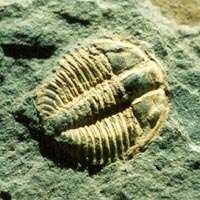Holyoakia
Holyoakia is a genus of very small (up to 7½ mm long) trilobites of the family Dorypygidae, from the late Lower Cambrian (Late Botonian) of South Australia and Antarctica.[1]
| Holyoakia | |
|---|---|
 | |
| Holyoakia simpsoni, © Dave Simpson | |
| Scientific classification | |
| Kingdom: | |
| Phylum: | |
| Class: | |
| Order: | |
| Suborder: | |
| Family: | |
| Genus: | Holyoakia Palmer in Palmer & Rowell, 1995 |
| Species | |
| |
Etymology
H. simpsoni was named in honor of David Simpson from Adelaide, who collected the first specimens.[1]
Distribution
- H. granulosa has only been collected from the late Lower Cambrian of Antarctica (presumably Botomian, Shackleton Limestone, Central Transantarctic Mountains)
- H. simpsoni only occurs in the late Lower Cambrian of South Australia (mid-late Botomian, Emu Bay Shale, Big Gully, Kangaroo Island).
Taxonomy
The genus was originally with reservation placed in the Emuellidae. The genus however lacks the specific characteristics of this family, most notably, the clearly furrowed glabella that is rounded at the frontal end, the hook-shaped eye ridges that run parallel to the margin of the head shield (or cephalon), clearly distinguishable prothorax of six segments, the most backward one with much larger spines than all others, and opistothorax of many segments, while the pygidium is tiny. Holyoakia however, has a rectangular glabella, difficult to discern eye ridges, a thorax of eight segments which is not differentiated and has no macropleural segment, and the pygidium is not much smaller than the cephalon.[1]
Ecology
H. simpsoni occurs together with Redlichia takooensis, Estaingia bilobata, Balcoracania dailyi, and Megapharanaspis nedini.
Key to the species
| 1 | Pygidium subtriangular, about 1½× as wide as long. Pygidial axis with 8 discernible rings. 6 pairs of pygidial pleura terminate in well developed spines. → H. granulosa |
|---|---|
| - | Pygidium transversely elliptical, more than 2× as wide as long. Pygidial axis with 5 discernible rings. 4 pairs of pygidial pleural furrows end in nodes. → H. simpsoni[1] |
References
- Paterson, R.J.; Jago, J.B. (2006). "New trilobites from the Lower Cambrian Emu Bay Shale Lagerstätte at Big Gully, Kangaroo Island, South Australia". Memoirs of the Association of Australasian Palaeontologists. 32: 43–57. hdl:1959.14/10651. ISSN 0810-8889.
Further reading
- Hagadorn, J.W. (2002). "Burgess Shale-type Localities: The global picture". In Bottjer, D.J.; W. Etter; J.W. Hagadorn; C.M. Tang (eds.). Exceptional Fossil Preservation -- A Unique View on the Evolution of Marine Life. Columbia University Press. ISBN 0231102542.
- Greg Edgecombe and the Australian Museum. "Australian Trilobites: A Species List and Bibliography". Retrieved August 23, 2005.CS1 maint: uses authors parameter (link)
- Sam Gon III. "A guide to the Orders of Trilobites". Retrieved August 23, 2005.
- Nedin, C. (1995). "The Emu Bay Shale, a Lower Cambrian fossil Lagerstätte, Kangaroo Island, South Australia". Memoirs of the Association of Australasian Palaeontologists. 18: 31–40.
- Simpson, Dave. "Trilobites of South Australia". Archived from the original on February 19, 2006. Retrieved August 23, 2005.